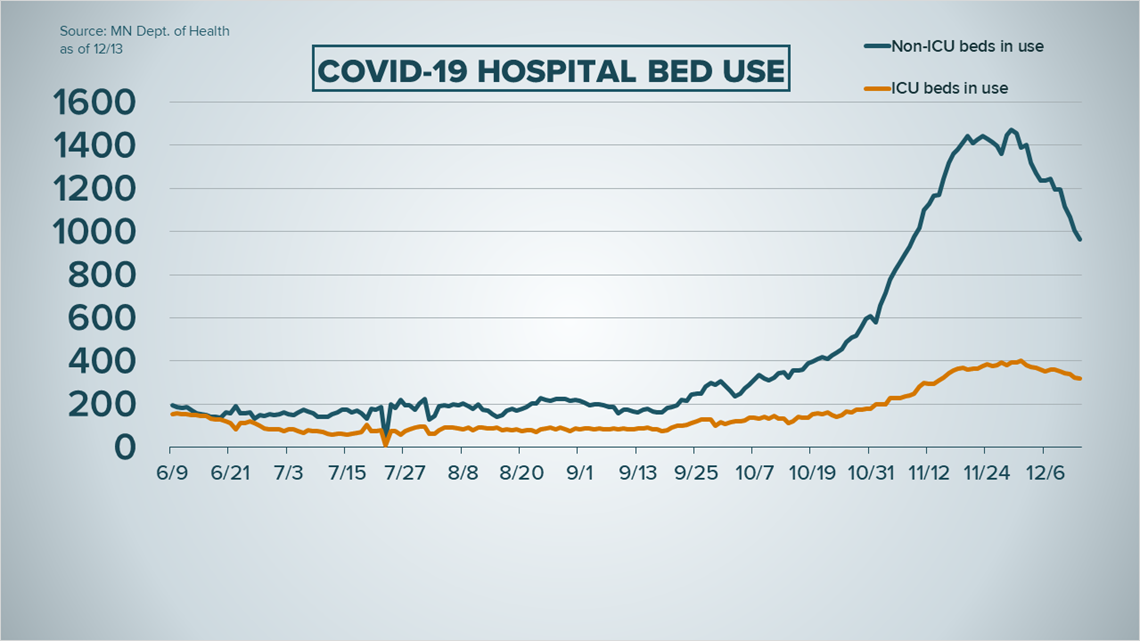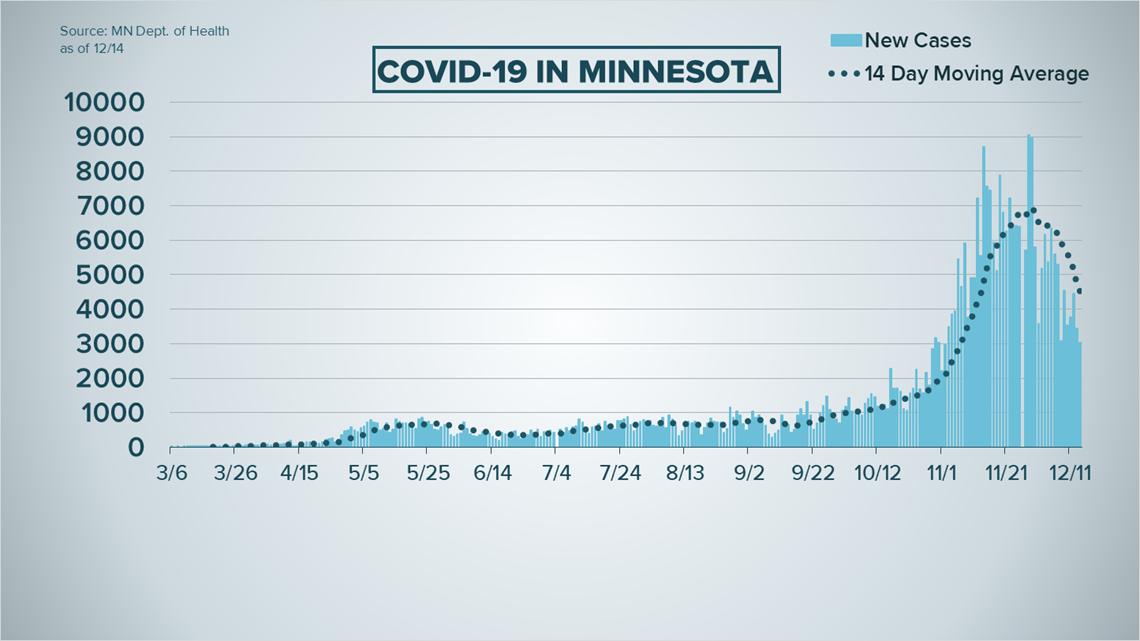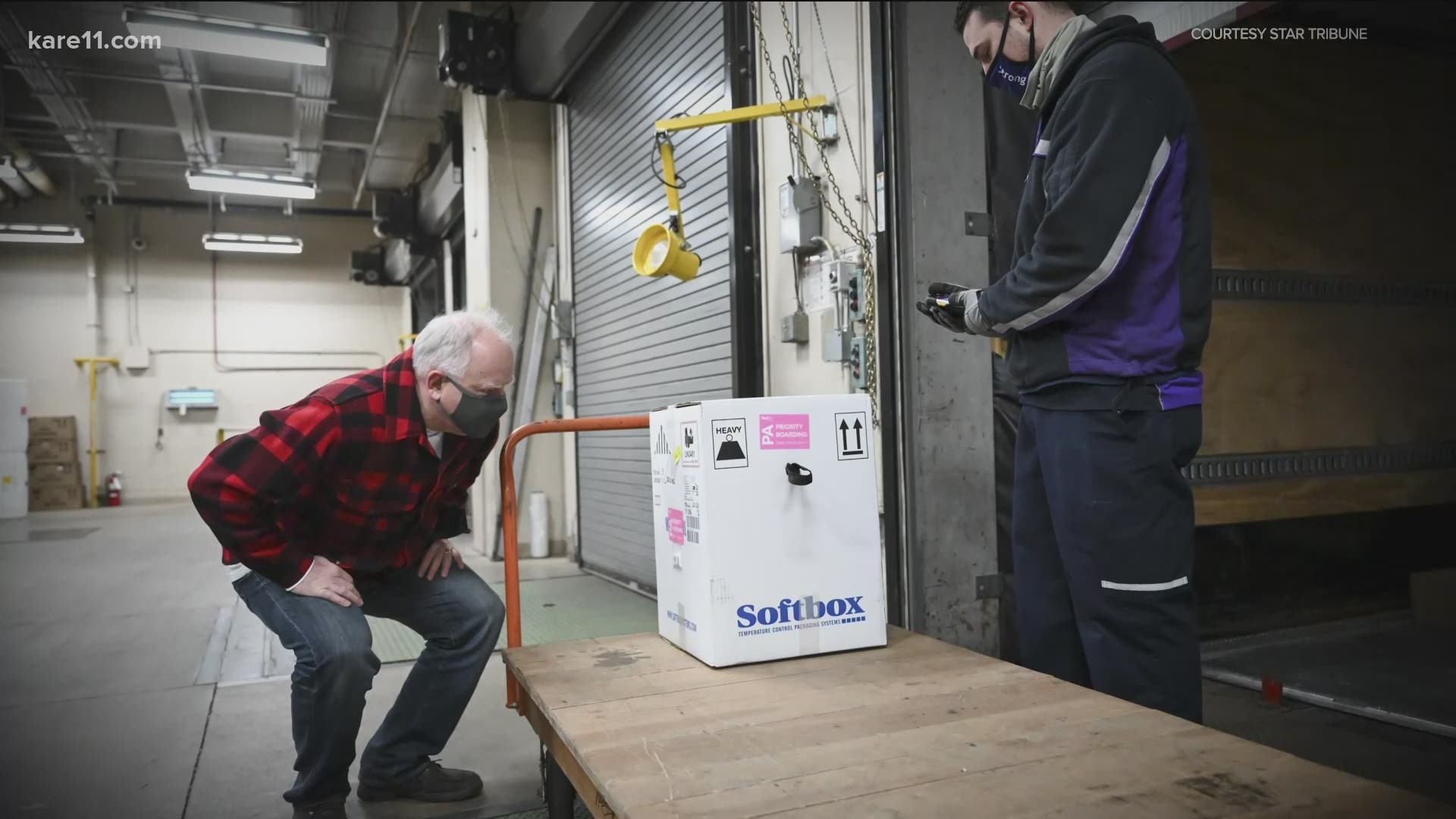ST PAUL, Minn. — Monday, Dec. 14
2 p.m.
In a press briefing on Monday afternoon, Minnesota Department of Health (MDH) Commissioner Jan Malcolm noted that it has been encouraging to see the number of hospital beds in use due to COVID trending downwards across the state. She added, however, that Minnesota is not "out of the woods," with statewide death counts from the virus still high.
Malcolm also said that there is still "a lot of virus" out there, and it is important for Minnesotans to continue, and even accelerate, the rate of improvement the state is seeing by still following guidelines such as masking and social distancing.
"We believe we can see the effects of Minnesotans taking this seriously and taking those mitigation measures to heart, and we appreciate that," she said. "We ask for people to continue to be very vigilant and help us get through this period of time in the best possible shape for our loved ones in our communities."
She said there are better days on the horizon, though, with the approval of the first COVID-19 vaccine in the United States.
According to MDH Infectious Disease Director Kris Ehresmann 46,800 units of vaccine are expected to be received across the state this week. Those will be sent to larger regional health care systems, which MDH is referring to as "hubs." From there, MDH will be using a "spoke-and-hub" model, where these larger "hub" sites will send the vaccine on to smaller hospitals and clinics, referred to as "spokes," where providers will administer the vaccine.
Long-term care residents and health care workers will be the first to be vaccinated in Minnesota, starting next week, and essential workers and older adults are anticipated to be in the second group.
The first shipment arrived this morning, and was sent to the Minneapolis Veterans Affairs Medical Center, Sanford Bemidji Medical Center, Olmsted Medical Center and Cass Lake Indian Health Services.
Ehresmann clarified that the Veterans Administration, the Indian Health Service, the Department of Defense, the Board of Prisons and the State Department are five channels who will be receiving vaccine directly from the federal government, and are therefore separate from the Minnesota allocation.
"They are on a completely different world, if you will, for vaccination," she said. "So when we talk about vaccination starting, we're talking about the providers in Minnesota that are not part of those five federal systems. So our training is for them and the plan for vaccination is for them. These other entities are separate from us, they order their vaccine separately."
Ehresmann also said it will be several months before the average Minnesotan can be vaccinated, but that these first vaccinations are a step in the right direction.
She stressed, though, that mitigation measures will still need to be practiced, even as more people get vaccinated.
"It's important to keep in mind even as we're celebrating the arrival of the vaccine, we need to continue to mask up, socially distance, and keep on with these mitigation measures," she said.
Ehresmann added that the focus in Minnesota is "safety, not speed," as the state is spending this week training workers in distribution of the vaccine. Vaccinations are expected to begin next week.
When asked to reflect on what effect the state's "pause" has had on slowing the spread of the virus, Ehresmann said that many of the spaces that have been closed since Nov. 20 are still having cases reported in connection to them due to the lag period in reporting, though those numbers have been reduced.
"What we've learned, and we continue to see, is that settings where people gather together in groups where masking is not happening or is not possible, is where we see transmission," Ehresmann said. "All of that information will continue to inform the governor's decision going forward."
11 a.m.
The number of COVID-19 deaths across the state dropped significantly Monday, according to data shared by the Minnesota Department of Health (MDH).
An additional 18 deaths from the virus were reported in the past 24 hours, down from 85 recorded Sunday. It is unclear whether the dramatic drop is due to weekend reporting. Monday's reported deaths bring the total in Minnesota to 4,462 since the onset of the pandemic.
MDH says an additional 3,026 cases of coronavirus were added to state totals over the past day, based on results from 45,341 tests (41,937 PCR, 3,404 Antigen) processed in private and state labs. Health officials consider a positive PCR test a confirmed case of COVID-19, while a positive Antigen test is labeled a probable case.
The new positives bring Minnesota's total cases of the virus to 381,841 since the pandemic arrived. Of those cases, 10,499 are based on Antigen tests.
Currently 1,283 beds in hospitals across the state are being used to treat COVID patients, a number that is dropping slowly but steadily. Of those beds 3,404 are in the ICU. Non-ICU bed availability across the Twin Cities is improving, listed at 4.7% open Monday. ICU beds are even more available, with 55 open across the Twin Cities metro (8.0 percent).


Total hospitalizations since the start of the pandemic have now reached 19,638, with 4,255 of those patients requiring ICU care.
Young adults make up the largest number of COVID cases in Minnesota, with 20 to 24-year-olds accounting for 39,478 cases and three deaths, followed by those 25 to 29 with 34,414 cases and five deaths. People 30 to 34 have recorded 31,778 cases with nine deaths.
The largest grouping of fatalities involves those ages 85 to 89, with 832 deaths in just 5,019 cases.
Hennepin County reports the most COVID activity in the state with 79,756 cases and 1,246 deaths, followed by Ramsey County with 34,016 cases and 592 deaths, Dakota County with 27,388 cases and 236 deaths, and Anoka County with 26,802 cases and 263 fatalities.
Cook County in northeastern Minnesota reports the least COVID activity with 97 cases and zero deaths.


Sunday, Dec. 13
2 p.m.
Meanwhile, Wisconsin's Department of Health Services (WDHS) reported 2,757 new cases Sunday, bringing the total number of cases statewide to 436,773.
Health officials reported 15 new deaths on Sunday as the total number of fatalities in Wisconsin rose to 4,056, which is approximately 0.9% of those testing positive for the virus.
Due to high case numbers, Gov. Tony Evers issued a new emergency order mandating indoor face coverings on Friday, Nov. 20 that will last 60 days.
On Oct. 6, Gov. Evers' administration issued a new order limiting the size of public indoor gatherings to 25% of capacity, to stem the spread of COVID-19. That order was struck down on Oct. 13 by a judge in Sawyer County. The order was reinstated on Oct. 19 by a Barron County judge, but on Oct. 23, a Wisconsin appeals court put a hold on the order.
Wisconsin health officials say a total of 19,249 people have been hospitalized from the coronavirus since the start of the pandemic, about 4.4% of the total number of people who have been diagnosed with the virus.
Of the confirmed cases in Wisconsin, 19% involve people between the ages of 20 to 29, 16% are between 30 and 39, 15% are between 50 and 59, and 14% are 40 to 49. An estimated 11% are between 10 and 19, and another 11% are between 60 and 69.
As of Sunday, Milwaukee County reported the largest number of confirmed cases with 77,118, along with 815 deaths. Dane County has reported 30,474 confirmed cases and 113 deaths, Waukesha County has reported 30,299 confirmed cases and 282 deaths, and Brown County has reported 24,332 cases and 150 deaths.
A more detailed breakdown of cases by county can be found on the DHS website.
11 a.m.
The Minnesota Department of Health (MDH) reported 3,439 new COVID-19 cases Sunday, along with 85 new deaths.
MDH's COVID-19 case definition includes both antigen testing and polymerase chain reaction (PCR) testing. Positive PCR test results are considered confirmed cases, while positive antigen test results are considered probable cases.
Sunday's new case total includes 3,181 confirmed cases and 258 probable cases.
The total number of Minnesotans who have tested positive for the virus since the pandemic began is now 378,823, with 10,289 of those as antigen test results.
MDH says 85 new deaths from the virus were reported, which pushes the total number of fatalities in Minnesota to 4,444.
To date, 19,536 Minnesotans have been hospitalized with the coronavirus since the pandemic started, with 4,228 of them needing care in the ICU.
MDH reports that 341,530 people once diagnosed with the virus have recovered enough that they no longer need isolation.
Of those who have tested positive, people between the ages of 20-24 account for the most cases with 39,199 cases and three deaths, and ages 25-29 follow with
34,147 cases and five deaths. Those between 85 and 89 years old account for the highest number of fatalities in one age group with 829 out of 4,975 cases.
In terms of likely exposure to the coronavirus, MDH says 76.427 cases were the result of community transmission with no known contact with an infected person, and 69,590 had known contact with a person who has a confirmed case.
A total of 30,642 cases involved exposure in a congregate living setting, 6,381 were in a corrections setting, and 593 were in a homeless shelter. MDH data shows 15,959 were linked to an outbreak outside of congregate living or health care.
MDH says 22,710 cases were linked to travel. Health care workers or patients account for 10,540 of diagnosed COVID-19 cases. The source of transmission for 145,981 cases is still unknown or missing.
MDH has prioritized testing for people in congregate care, hospitalized patients and health care workers, which may impact the scale of those numbers. However, now MDH is urging anyone who is symptomatic or even asymptomatic to be tested. Testing locations can be found online.
Hennepin County has the most COVID activity in the state with 79,134 cases and 1,243 deaths, followed by Ramsey County with 33,697 cases and 590 deaths, Dakota County with 27,132 cases and 234 deaths and Anoka County with 26,575 cases and 262 deaths.
Full data, including a breakdown of PCR and antigen test totals in some categories, can be found on MDH's website.
The Minnesota Department of Health has said repeatedly that the number of lab-confirmed cases is only the "tip of the iceberg" when it comes to the true number of COVID-19 cases in the state.
The state of Minnesota has set up a data portal at mn.gov/covid19.
KARE 11’s coverage of the coronavirus is rooted in Facts, not Fear. Visit kare11.com/coronavirus for comprehensive coverage, find out what you need to know about the Midwest specifically, learn more about the symptoms, and see what businesses are open as the state slowly lifts restrictions. Have a question? Text it to us at 763-797-7215. And get the latest coronavirus updates sent right to your inbox every morning. Subscribe to the KARE 11 Sunrise newsletter here. Help local families in need: www.kare11.com/give11.
The state of Minnesota has set up a data portal online at mn.gov/covid19.

